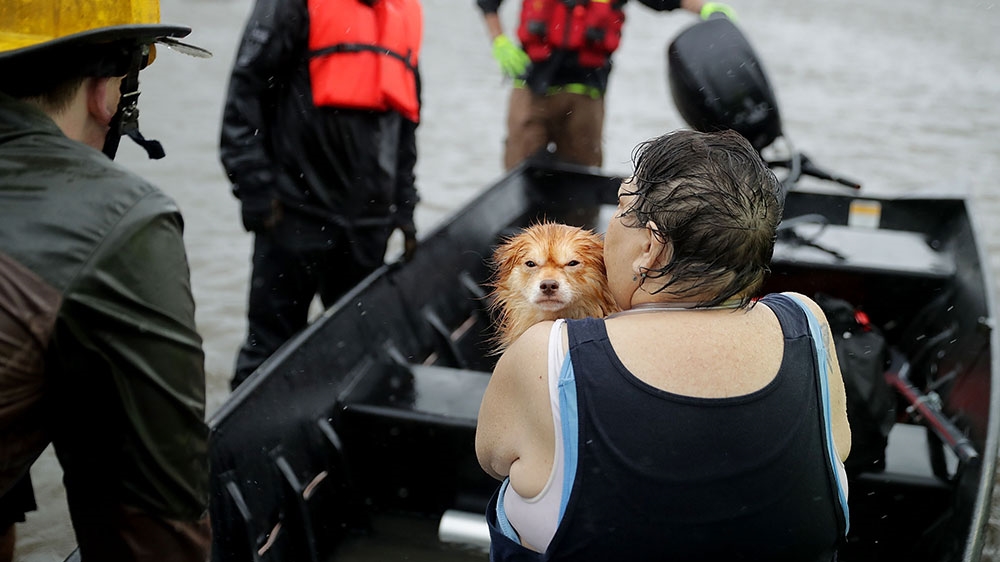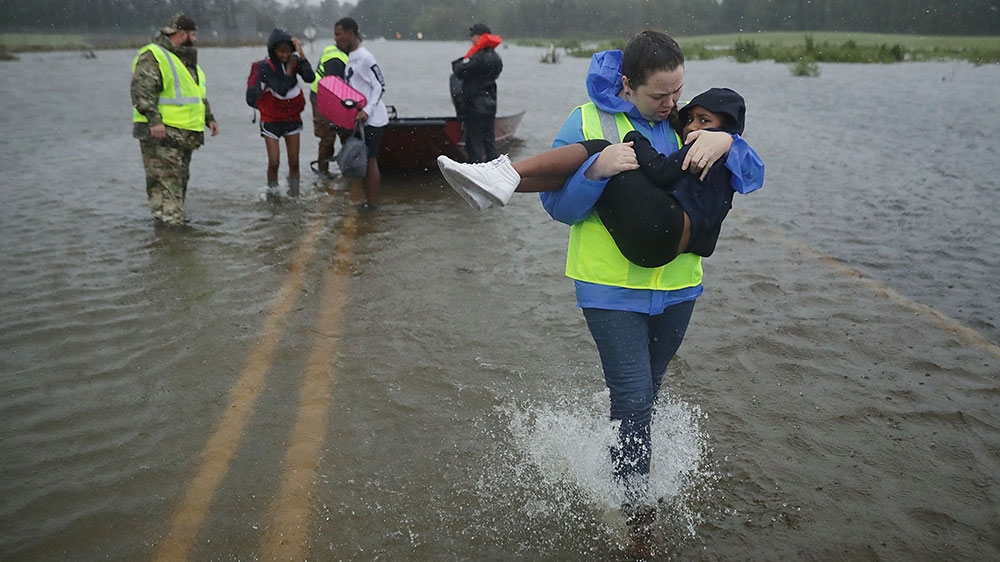SOURCE: Al Jazeera and news agencies
Hurricane Florence: Woman, baby die after tree falls on house
A woman and her child died after a tree fell on their house in Wilmington, North Carolina, the first reported fatalities from Hurricane Florence, which made landfall earlier on Friday.
Police confirmed the fatalities on Twitter, saying the father of the child was being transported to a local medical centre to be treated for his injuries.
The reports came just hours after Florence made landfall as a Category 1 hurricane at 7:15am local time (11:30 GMT) at Wrightsville Beach, a few miles east of Wilmington, as the centre of its eye moved onshore, the National Hurricane Center said.
The eye of the storm and its outer edges pushed a life-threatening storm surge of floodwater miles inland and ripped apart buildings with screaming wind and pelting rain.
“The worst of the storm is not yet here, but these are the early warnings of the days to come,” North Carolina Governor Roy Cooper told reporters just before the hurricane made landfall. “Surviving this storm with be a test of endurance, teamwork, common sense and patience.”
WPD can confirm the first two fatalities of Hurricane #Florence in Wilmington. A mother and infant were killed when a tree fell on their house. The father was transported to NHRMC with injuries. https://t.co/FC5PAhuxig
— Wilmington Police (@WilmingtonPD) September 14, 2018
Coastal streets flowed with ocean water, and more than 460,000 homes and businesses were without power, mostly in North Carolina, according to poweroutage.us, which tracks the nation’s electrical grid.
‘Not acting like a normal hurricane’
Forecasters said “catastrophic” freshwater flooding was expected along waterways far from the coast of North and South Carolina.
They added that the onslaught would last for hours because Florence was barely creeping along at 9km an hour and still drawing energy from the ocean.
“A big worry about Hurricane Florence is that it’s not acting like a normal hurricane,” said Al Jazeera’s Andy Gallacher, reporting from Wilmington, North Carolina.
“Hurricanes normally come in and they go inland, which sucks the power out of them as they go over the land,” he said. “This one is set to linger right where it is for at least 48 hours.”
 |
| Rescue workers and volunteers rescue a woman and her dog from their flooded home during Hurricane Florence [Chip Somodevilla/Getty Images/AFP] |
Hurricane-force winds extended 130km from its centre, and tropical storm-force winds reached out to 315km.
Winds bent trees towards the ground and raindrops flew sideways as Florence moved in for an extended stay, with enough of its killer winds swirling overseas to maintain its power.
 |
| The Neuse River floods the waterfront in New Bern, North Carolina, on September 14, 2018 during Hurricane Florence [Logan Cyrus/AFP] |
The wind howled and sheets of rain splattered against windows of a hotel before dawn in Wilmington, where Sandie Orsa of Wilmington sat in a lobby lit by emergency lights after the power failed.
“[It’s] very eerie, the wind howling, the rain blowing sideways, debris flying,” Orsa, who lives nearby and fears splintering trees will pummel her house, told The Associated Press.
The rising sea crept towards the two-storey home of Tom Copeland, who lives on a spit of land surrounded by water in Swansboro. Winds knocked down trees all over.
The water “is as high as it’s ever been and waves are breaking on my point, which is normally grass,” said Copeland, a freelance photographer for The Associated Press.
“Trees are blowing down in the wind. Nothing’s hit the house yet, but it’s still blowing.”
A gust of 169km/h was recorded at Wilmington airport, surpassing the power of Hurricane Fran two decades ago.
 |
| Rescuers search a flooded neighbourhood in Fairfield Habour, North Carolina for evacuees during Hurricane Florence [Chip Somodevilla/Getty Images/AFP] |
The National Hurricane Center said a gauge north of Wilmington in Emerald Isle, North Carolina, reported 1.92 metres of inundation.
‘Not a lot of time’
Early on Friday, South Carolina emergency officials said there was still time, “but not a lot of time” for people to leave flood-prone areas.
More than 12,000 were in shelters in North Carolina. Another 400 people were in shelters in Virginia, where forecasts were less dire.
Officials said some 1.7 million people in the Carolinas and Virginia were warned to evacuate, but it’s unclear how many did. The homes of about 10 million were under watches or warnings for the hurricane or tropical storm conditions. Coastal towns in the Carolinas were largely empty, and schools and businesses closed as far south as Georgia.
Forecasters said Florence’s surge could cover all but a sliver of the Carolina coast under as much as 3.4 metres of ocean water, and days of downpours could unload more than 0.9 metres of rain, touching off severe flooding.
 |
| Volunteers help rescue three children from their flooded home in James City, North Carolina [Chip Somodevilla/Getty Images/AFP] |
Once a Category-4 hurricane with winds of 225kph, the hurricane was downgraded to Category 1 on Thursday night.
Forecasters said that given the storm’s size and sluggish track, it could cause epic damage akin to what the Houston area saw during Hurricane Harvey just over a year ago, with floodwaters swamping homes and businesses and washing over industrial waste sites and hog-manure ponds.
Florence was seen as a major test for the Federal Emergency Management Agency, which was heavily criticised as slow and unprepared last year for Hurricane Maria in Puerto Rico.
More than a million people have been ordered to evacuate as Hurricane Florence approaches the East Coast. pic.twitter.com/ybNagWym8y
— AJ+ (@ajplus) September 11, 2018




